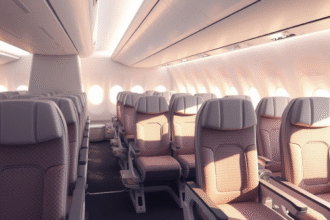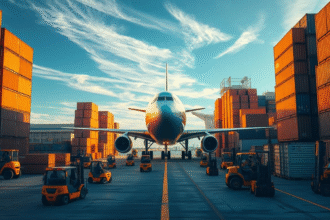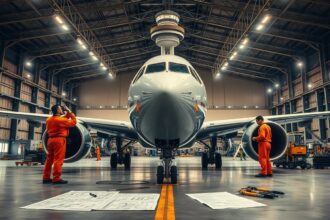Exploring in-flight dining, I see a big change in airplane food on international flights. No more bland, mass-produced meals. Today, airlines offer a wide range of tasty dishes.
food provide
The in-flight meal you get depends on several things. This includes the airline, the class of service, and the flight route. You can find everything from fancy fine dining to simple snacks.
In this article, we’ll look at the different classes of service and what you can expect to eat. We’ll also talk about what makes the dining experience special at 35,000 feet.
Key Takeaways
- The evolution of in-flight dining has transformed the airplane food experience.
- Airlines offer diverse culinary experiences on international flights.
- The type of in-flight meal served depends on the airline, class of service, and route.
- Luxurious fine dining and simple snacks are available options.
- The class of service plays a significant role in determining the in-flight meal experience.
The Evolution of Airplane Food
The history of airline food is a story of growth and change. It has been shaped by new technologies, shifting tastes, and money matters. As flying became more common, so did the need for better meals on planes.
Early Days of In-Flight Dining
In the beginning, meals on planes were simple. Passengers got sandwiches or snacks because of food storage limits. As flying grew, airlines worked to make their meals better.
evolution of airline food
How Airplane Food Has Changed Over Decades
Over time, airplane food has changed a lot. New food tech, changing tastes, and money issues have played big roles. Airlines now offer more choices, including meals for different diets and tastes.
The demand for better food and the rise of budget airlines have also shaped in-flight meals. Today, you can find a wide range of tasty options on flights.
How Airlines Food Provide Services on International Flights
Providing food on international flights is a complex task. Airlines must plan carefully, considering many factors. These include what passengers can eat, their meal choices, and how to keep food hot at 35,000 feet.
Behind-the-Scenes of Airplane Meal Preparation
Preparing meals for flights is key. Airlines team up with catering companies to make safe, tasty meals. They plan everything, from menus to how to store and heat food.
Singapore Airlines is famous for its gourmet meals. These are made by top chefs to meet different tastes and dietary needs.
airline meal preparation
A culinary expert says, “The goal of in-flight dining is to make passengers feel special.” This is seen in the detailed meal preparation.
Logistics of Serving Thousands of Meals Daily
Feeding thousands of passengers daily is a big challenge. Airlines must manage meal storage, reheating, and serving. They keep quality and safety high, using special equipment to store and reheat meals.
Good logistics are essential for airline food services. By improving their operations, airlines can offer better meals. This makes the flying experience better for everyone.
First Class Dining Experiences
At 35,000 feet, fine dining takes off in first class. It’s more than just food; it’s luxury and service. Passengers get a unique taste adventure.
Gourmet Meals and Fine Dining
Gourmet meals in first class are top-notch. They use the best ingredients and new cooking methods. Meals are both beautiful and tasty.
Key features of gourmet meals in first class include:
- High-quality, seasonal ingredients
- Innovative culinary techniques
- Personalized menu options
- Fine wines and champagnes
| Airline | Gourmet Meal Option | Notable Feature |
| Emirates | Caviar and Truffle Risotto | Use of luxurious ingredients |
| Singapore Airlines | Kabocha Squash Soup | Innovative flavor combinations |
| Qatar Airways | Grilled Salmon with Quinoa | High-quality protein options |
Celebrity Chef Collaborations
Airlines team up with famous chefs for better in-flight food. These partnerships add a special touch to meals in the air.
For example, Singapore Airlines teamed up with Chef Anna Hansen. Together, they made a menu that shows the airline’s focus on quality and new ideas.
By mixing gourmet meals with celebrity chefs’ skills, airlines are changing first class dining. It makes flying an unforgettable experience for everyone.
Business Class Food Offerings
Flying business class means enjoying top-notch meals and fine wines at 35,000 feet. As a business traveler, you get a much better dining experience than in economy class.
Premium Dining Options for Business Travelers
Business class passengers enjoy meals made by famous chefs. These premium meals are made for travelers who love good food. You’ll find gourmet dishes and fine wines at every turn.
The ingredients and how the dishes are presented are very important. Meals are served on fine china, and the cutlery is top-notch. This adds to the luxurious feel of the dining experience.
Wine and Beverage Programs in Business Class
The wine and beverage programs are a big part of business class dining. Airlines work with sommeliers to pick wines that go well with their meals. You can choose from fine wines, champagnes, and premium spirits.
There’s more than just wine, though. Business class passengers can also enjoy specialty cocktails, artisanal beers, and gourmet coffee. The drink service is meant to be both refreshing and indulgent, making your flight more fun.
Economy Class Meal Services
Airlines are trying to make economy class meals better to meet what passengers want. Even though economy class isn’t as fancy as other classes, many airlines are working hard. They want to give good food to travelers who are watching their budget.
Standard Meal Options in Economy
In economy class, passengers usually get to choose from a few meals. These might be chicken, beef, or vegetarian dishes, with a side and dessert. The choices can change based on the airline, flight length, and time of day.
For long flights, airlines like Singapore Airlines and Qatar Airways serve high-quality meals. Sometimes, these meals are even made by famous chefs. But, on shorter flights, you might just get a snack or a light meal.
How Airlines Differentiate Their Economy Food
Airlines try to make their economy food stand out in different ways. Some use top-quality, local ingredients. Others come up with unique dishes or work with famous chefs.
| Airline | Meal Option | Special Feature |
| Singapore Airlines | Chicken or Beef | Celebrity Chef Designed |
| Qatar Airways | Vegetarian or Meat | Locally Sourced Ingredients |
| Emirates | International Cuisine | Onboard Chef Preparation |
Looking at these strategies, it’s clear airlines are serious about making economy class meals better. They want to make flying more fun for millions of people around the world.
Special Dietary Meals on International Flights
International flights now offer special meal options for passengers with specific needs. This makes travel more comfortable. Airlines cater to diverse dietary requirements, for religious, cultural, or health reasons.
Religious and Cultural Dietary Accommodations
Many airlines provide meals that fit religious and cultural dietary restrictions. For example, kosher and halal meals are available on international flights. These meals are made under strict guidelines to meet the required standards.
A survey shows over 70% of airlines offer kosher meals, and more than 80% provide halal meals. This helps passengers follow their dietary beliefs even at 30,000 feet.
Vegetarian, Vegan, and Allergen-Free Options
Airlines also offer vegetarian, vegan, and allergen-free meal options. These choices cater to passengers with specific dietary needs. This ensures they enjoy a pleasant dining experience onboard.
Vegan meal options are becoming more popular, with a 20% increase in requests over the past year. Allergen-free meals are also common, with airlines working to prevent cross-contamination.
| Meal Type | Availability | Special Features |
| Halal | 80% of airlines | Prepared under Islamic guidelines |
| Kosher | 70% of airlines | Rabbinical supervision |
| Vegan | Increasing | Plant-based ingredients |
How to Request Special Meals When Booking
To get these special meal options, passengers can request them during booking or by contacting the airline’s customer service. It’s best to request them at least 24 hours in advance to ensure availability.
An airline representative said, “We strive to meet all dietary needs. Passengers should not hesitate to contact us with their requests.”
Cultural Variations in Airline Food
Airlines fly all over the world, serving food that meets the tastes of many cultures. This is key to making flying more fun and personal for everyone. By adding cultural touches to their meals, airlines show off the food traditions of the places they visit.
How Airlines Adapt Menus for Different Routes
Airlines know that what people like to eat changes with their destination. For example, on trips to Asia, they might serve dishes like sushi or stir-fry, which are popular there. On flights to Europe, they might offer Mediterranean dishes like pasta or tapas. They adjust not just the food but also drinks and desserts.
“The secret to great in-flight food is knowing what our passengers like,” says a chef for airlines. “By adding local flavors and dishes, we make flying more enjoyable for everyone.”
Regional Specialties Served on International Carriers
International flights often highlight local dishes. Japan Airlines, for instance, serves sushi and ramen, showing off Japan’s food culture. Air India offers Indian dishes like curries and biryani, highlighting India’s food diversity. These dishes not only please local passengers but also give international travelers a taste of home.
By using cultural flavors in their menus, airlines can stand out and make flying memorable. As the airline world grows, including many cuisines will keep being a big part of flying.
Airlines Known for Exceptional Food
Exceptional airline food is more than just food; it’s an experience. Some airlines really get it right. When you fly internationally, the food can make or break your trip.
Some airlines are famous for their amazing food in the sky. They know that great food is part of their service.
Top-Rated International Airlines for Dining
Singapore Airlines, Qatar Airways, and Japan Airlines are at the top for dining. They use the best ingredients and new cooking methods.
Singapore Airlines is known for its exceptional airline food. They serve dishes that show off Singapore’s rich food culture. Qatar Airways is praised for its gourmet meals that please many tastes and needs.
What Sets These Airlines Apart in Food Service
So, what makes these airlines stand out in food service excellence? They pay close attention to meal prep. They choose the best ingredients and present the dishes beautifully.
They also change their menus for different places and tastes. They serve regional specialties and meet many dietary needs. This makes the trip better and shows they’re a top-rated airline.
By focusing on quality, new ideas, and cultural awareness, these airlines have set a high standard for in-flight food. They’re leaders in international air travel.
The Challenges of Taste at High Altitude
High altitude is tough on airline passengers’ taste buds. At cruising altitudes, around 35,000 feet, the air is thinner and drier. This changes how we taste food.
How Altitude Affects Flavor Perception
The dry air and lower pressure at high altitudes mess with our taste and smell. “Studies show that sweetness and saltiness sensitivity can drop by 30% at high altitudes,” a food scientist notes. This makes enjoying meals harder for passengers.
How Airlines Compensate for Taste Changes
Airlines have found ways to deal with taste changes at high altitudes. They adjust the seasoning in their meals.
Seasoning Adjustments for Altitude
To fight the taste dullness of high altitude, some airlines add more seasoning to their dishes. Adding herbs and spices can boost flavor.
Specialized Cooking Techniques
Airlines also use specialized cooking techniques to keep meals tasty. They choose ingredients that stay moist and flavorful, even in dry air.
By tackling the taste challenges of high altitude, airlines can make dining better for their passengers.
Sustainability Initiatives in Airline Food Service
Airlines are now focusing on sustainability initiatives in their food and drinks. This change is good for the planet and makes flying better for everyone.
The airline industry creates a lot of waste, like disposable items and packaging. So, airlines are working hard to cut down on this waste.
Reducing Food Waste on International Flights
Airlines are working to reduce food waste. They plan meals carefully to match what passengers want. Some even let passengers pre-order meals to avoid extra food.
Using data to guess what meals are popular helps too. This way, airlines waste less food and save money on disposal.
Eco-Friendly Packaging and Serving Materials
Airlines are also using eco-friendly packaging and serving materials. They’re switching to biodegradable or compostable items instead of plastic. Some are even using sustainable materials for in-flight items.
For example, some airlines use paper straws or don’t use single-use plastics at all. Others use recyclable or biodegradable containers for meals, which helps the environment.
These sustainability initiatives make airlines more eco-friendly. They also set a new standard for in-flight dining.
Tips for Enhancing Your In-Flight Dining Experience
Getting ready for a long flight means thinking ahead. You can make your in-flight meal better by being prepared and flexible. Look at what your airline offers to make your meal time enjoyable.
Pre-Flight Meal Planning for Long-Haul Journeys
Planning your meal before flying is key for long trips. Look at the menu on your airline’s website. They often have special meals like vegetarian, vegan, and gluten-free options if you book early. Planning ahead means you’ll get a meal that fits your diet and taste.
For instance, Singapore Airlines has a wide range of meals. They even offer local dishes that match different tastes. Knowing what your airline has can make your meal better.
Bringing Supplementary Snacks and Beverages
Bringing your own snacks and drinks can also improve your flight. Snacks like nuts, dried fruits, or energy bars are easy to pack. But, always check with your airline about food and drink rules.
| Snack Type | Benefits | Considerations |
| Nuts and Dried Fruits | Healthy and filling | May be subject to airline restrictions |
| Energy Bars | Convenient and energizing | Check ingredients for allergens |
| Homemade Snacks | Customizable to dietary needs | Ensure compliance with airline regulations |
As
“The art of flying is not just about reaching your destination, it’s about enjoying the journey.”
Conclusion
Exploring airplane food on international flights shows it’s a complex topic. It’s shaped by culture, diet needs, and the challenges of flying.
Airline food has changed a lot. Now, some flights offer fancy meals, while others stick to basic options.
Knowing about airline food helps us appreciate the hard work behind it. Whether you fly often or just sometimes, knowing what’s available can make your flight better.
Airlines are working to meet new needs and tastes. They’re focusing on green food, special meals, and better dining.
FAQ
What types of meals are typically served on international flights?
Meals on international flights vary by airline, class, and route. You might find Western meals, Asian dishes, or special options like vegetarian or vegan.
Can I request a special meal on an international flight?
Yes, many airlines offer special meals. This includes options for religious, cultural, vegetarian, vegan, and allergen-free diets. Just ask when you book or at least 24 hours before.
How do airlines adapt their menus for different routes and cultural preferences?
Airlines tailor their menus to local tastes and cultures. For example, Asian flights might serve Asian dishes, while European flights offer European meals.
Are there any airlines known for their exceptional in-flight dining experiences?
Yes, some airlines are famous for their in-flight dining. They work with celebrity chefs to create gourmet meals and offer fine wines and drinks.
How does high altitude affect the taste of food on a plane?
High altitude can make food taste different. The dry air and low pressure can dull taste. Airlines adjust seasoning and cooking to counteract this.
Can I bring my own food on an international flight?
Yes, you can bring your own food. Just check with your airline for any rules or guidelines.
How do airlines reduce food waste on international flights?
Airlines try to cut down on food waste. They serve less food, use efficient systems, and donate leftovers to charities.
What are some tips for improving my in-flight dining experience?
To make your meal better, plan ahead, bring snacks and drinks, and choose airlines known for great food service.







